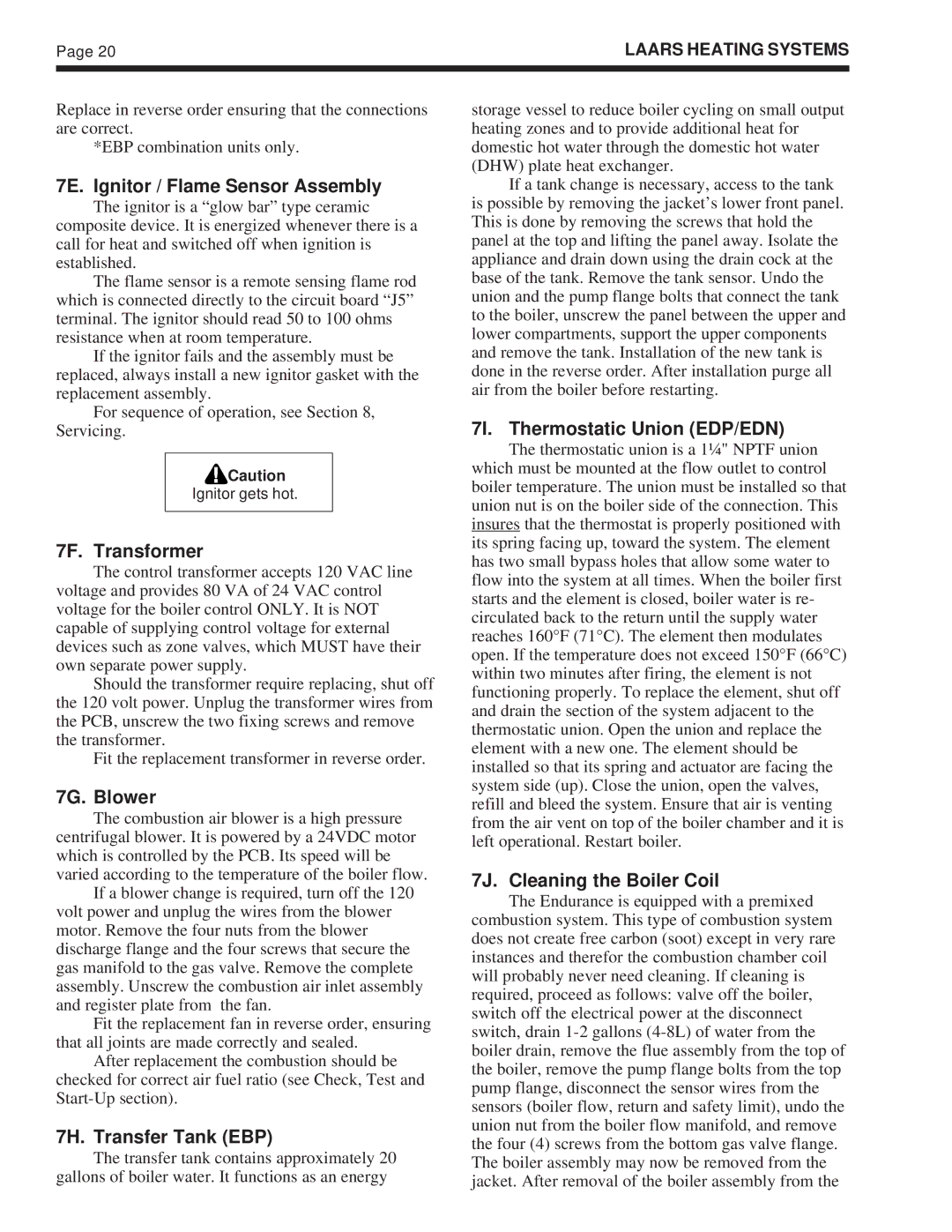
Page 20 | LAARS HEATING SYSTEMS |
|
|
|
|
Replace in reverse order ensuring that the connections are correct.
*EBP combination units only.
7E. Ignitor / Flame Sensor Assembly
The ignitor is a “glow bar” type ceramic composite device. It is energized whenever there is a call for heat and switched off when ignition is established.
The flame sensor is a remote sensing flame rod which is connected directly to the circuit board “J5” terminal. The ignitor should read 50 to 100 ohms resistance when at room temperature.
If the ignitor fails and the assembly must be replaced, always install a new ignitor gasket with the replacement assembly.
For sequence of operation, see Section 8, Servicing.
![]()
![]() Caution
Caution
Ignitor gets hot.
7F. Transformer
The control transformer accepts 120 VAC line voltage and provides 80 VA of 24 VAC control voltage for the boiler control ONLY. It is NOT capable of supplying control voltage for external devices such as zone valves, which MUST have their own separate power supply.
Should the transformer require replacing, shut off the 120 volt power. Unplug the transformer wires from the PCB, unscrew the two fixing screws and remove the transformer.
Fit the replacement transformer in reverse order.
7G. Blower
The combustion air blower is a high pressure centrifugal blower. It is powered by a 24VDC motor which is controlled by the PCB. Its speed will be varied according to the temperature of the boiler flow.
If a blower change is required, turn off the 120 volt power and unplug the wires from the blower motor. Remove the four nuts from the blower discharge flange and the four screws that secure the gas manifold to the gas valve. Remove the complete assembly. Unscrew the combustion air inlet assembly and register plate from the fan.
Fit the replacement fan in reverse order, ensuring that all joints are made correctly and sealed.
After replacement the combustion should be checked for correct air fuel ratio (see Check, Test and
7H. Transfer Tank (EBP)
The transfer tank contains approximately 20 gallons of boiler water. It functions as an energy
storage vessel to reduce boiler cycling on small output heating zones and to provide additional heat for domestic hot water through the domestic hot water (DHW) plate heat exchanger.
If a tank change is necessary, access to the tank is possible by removing the jacket’s lower front panel. This is done by removing the screws that hold the panel at the top and lifting the panel away. Isolate the appliance and drain down using the drain cock at the base of the tank. Remove the tank sensor. Undo the union and the pump flange bolts that connect the tank to the boiler, unscrew the panel between the upper and lower compartments, support the upper components and remove the tank. Installation of the new tank is done in the reverse order. After installation purge all air from the boiler before restarting.
7I. Thermostatic Union (EDP/EDN)
The thermostatic union is a 1¼" NPTF union which must be mounted at the flow outlet to control boiler temperature. The union must be installed so that union nut is on the boiler side of the connection. This insures that the thermostat is properly positioned with its spring facing up, toward the system. The element has two small bypass holes that allow some water to flow into the system at all times. When the boiler first starts and the element is closed, boiler water is re- circulated back to the return until the supply water reaches 160°F (71°C). The element then modulates open. If the temperature does not exceed 150°F (66°C) within two minutes after firing, the element is not functioning properly. To replace the element, shut off and drain the section of the system adjacent to the thermostatic union. Open the union and replace the element with a new one. The element should be installed so that its spring and actuator are facing the system side (up). Close the union, open the valves, refill and bleed the system. Ensure that air is venting from the air vent on top of the boiler chamber and it is left operational. Restart boiler.
7J. Cleaning the Boiler Coil
The Endurance is equipped with a premixed combustion system. This type of combustion system does not create free carbon (soot) except in very rare instances and therefor the combustion chamber coil will probably never need cleaning. If cleaning is required, proceed as follows: valve off the boiler, switch off the electrical power at the disconnect switch, drain
